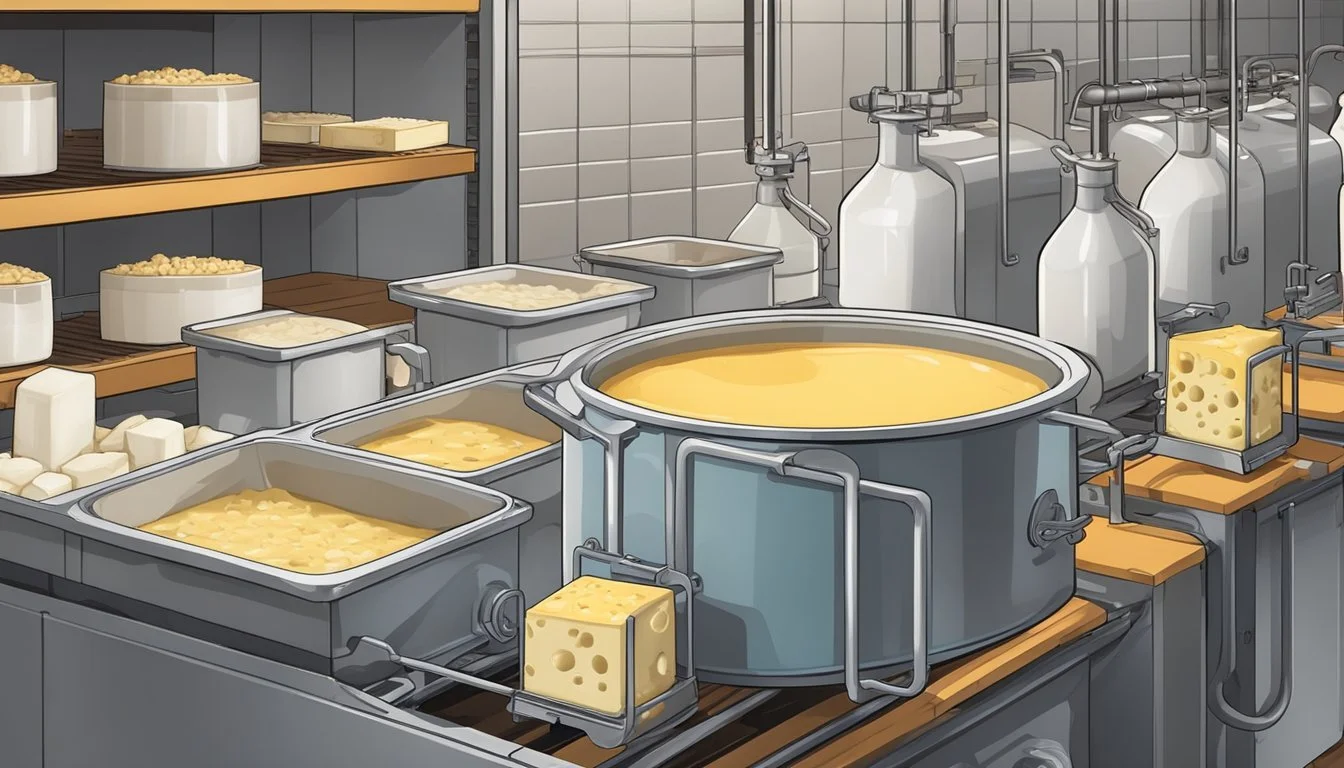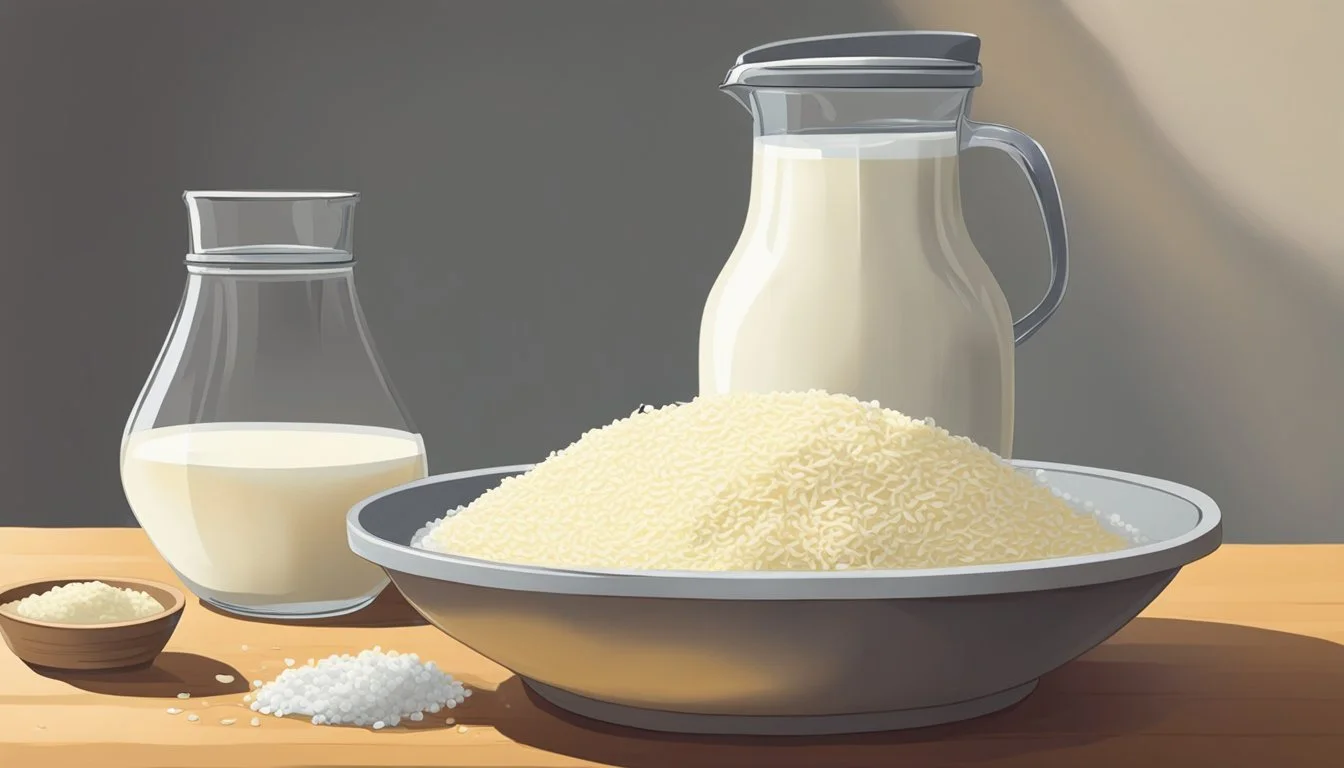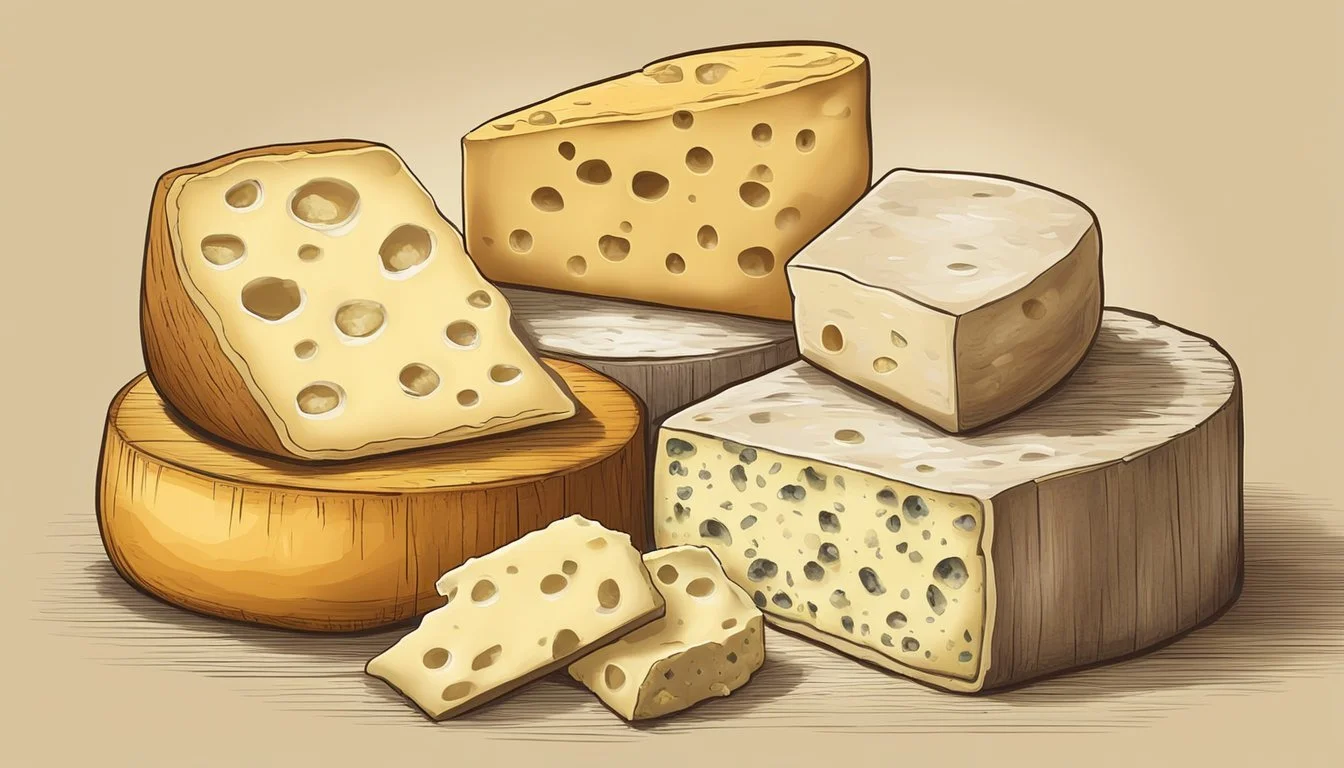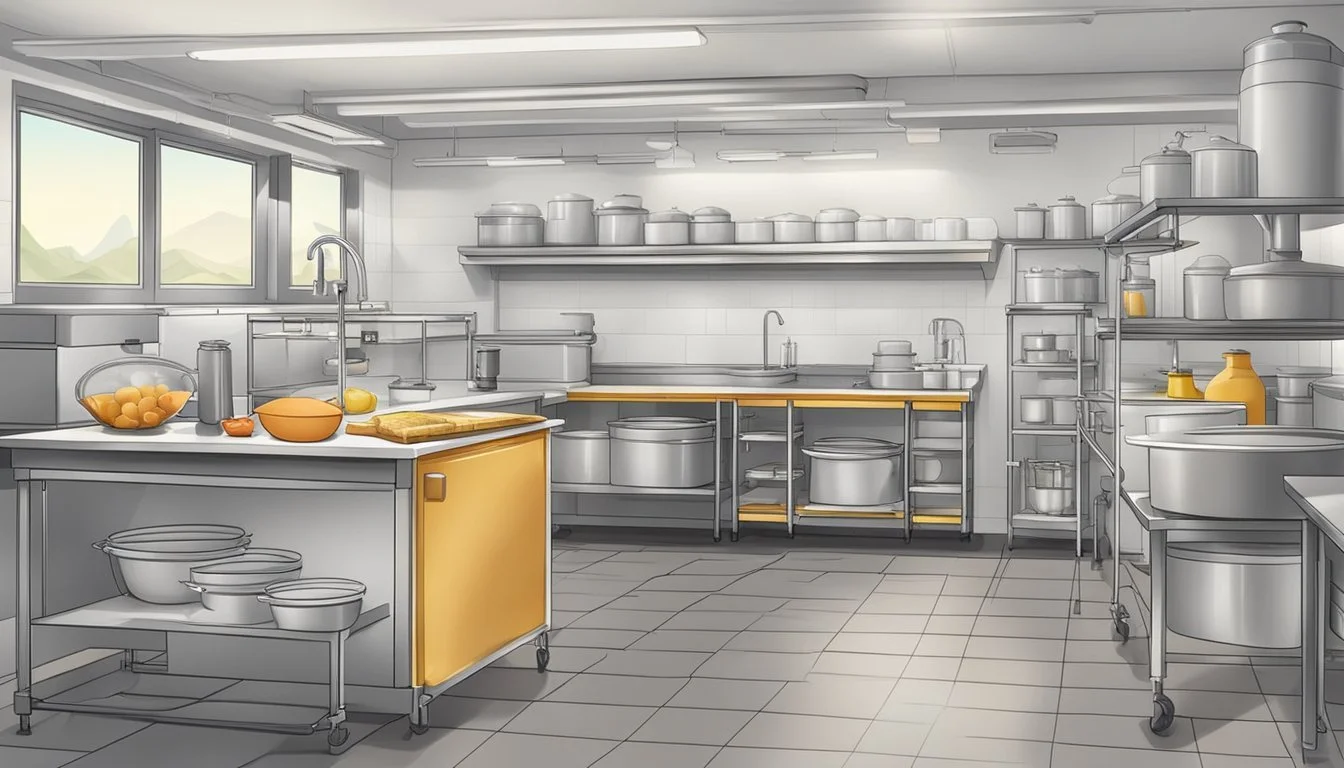How to Ferment Cheese
Mastering the Basics of Cheese Making
Fermenting cheese is an ancient technique that transforms milk into a flavorful and enduring food product. It involves introducing specific bacteria, known as cultures, to milk and controlling the environment in which the cheese (What wine goes well with cheese?) matures. This process not only ensures the development of the desired texture and flavor profiles in the cheese but also contributes to its longevity and safety for consumption.
The fermentation of cheese is carried out by lactic acid bacteria, which play a crucial role in defining the cheese's characteristics. These cultures consume lactose, the sugar present in milk, and produce lactic acid, leading to the milk's coagulation. The result is curds, which are then processed further to become the cheese that consumers enjoy.
As cheese ferments, its flavor continues to evolve. The aging period can vary significantly, from a few days for soft cheeses (What wine goes well with soft cheeses?) to several months or even years for hard cheeses. Throughout aging, the bacteria and enzymes present continue to act on the cheese, developing complex flavors and textures that are unique to each variety. The controlled environment for aging, typically cool and humid, is essential for this gradual transformation, ultimately yielding a range of cheeses that are appreciated worldwide for their diverse and nuanced flavors.
The Basics of Fermentation
In the context of cheese-making, fermentation is a controlled process where specific strains of bacteria, yeasts, or molds are introduced to milk to produce desirable changes in flavor, texture, and nutritional properties.
Understanding Fermentation
Fermentation is a metabolic process where microorganisms like bacteria and yeast convert sugars and starches into lactic acid. This process is essential in cheese-making, as it not only influences the flavor profiles but also contributes to the food's safety and shelf-life. Lactic acid is a vital by-product, creating an environment that preserves the cheese and enhances its flavors. The activity of these microorganisms, which can be thought of as beneficial probiotics, brings about the transformation of the milk's carbohydrates, fats, and proteins.
Key Components of Fermentation in Cheese-Making:
Microorganisms: Introduce beneficial bacteria, yeast, or molds.
Lactic Acid Production: These cultures metabolize lactose, producing lactic acid.
Flavor Development: The gradual acidification leads to distinct flavors and aromas.
Preservation: Acidic environments inhibit harmful bacteria, extending shelf-life.
Types of Cheese for Fermentation
Cheese varieties are nearly as diverse as the cultures used to ferment them. Different cheeses require specific strains of microorganisms for fermentation, which in turn lend each type its unique characteristics.
Soft Cheeses: These often involve a shorter fermentation period and may feature yeasts or molds, such as Penicillium camemberti in Brie.
Hard Cheeses: These typically undergo a longer fermentation, with bacteria playing a more significant role. Cheddar, for instance, relies on strains that result in a firmer texture and deeper flavor.
Using the right combination of cultures is crucial for achieving the desired taste and quality of the cheese. Each culture imparts distinct aromatic compounds and textures, marking the difference between a creamy Camembert and a robust Cheddar.
Preparing the Ingredients
In crafting fermented cheese, selecting high-quality ingredients is crucial for both flavor and successful fermentation. This section details the foundational elements needed to start the cheese-making process.
Choosing the Right Milk
The cornerstone of cheese fermentation is milk, which should be of high quality and freshness. One has to decide between using raw or pasteurized milk, knowing that raw milk can imbue a more complex flavor profile but also poses a risk of harmful bacteria. The milk's richness, denoted by its fat content, affects the texture and taste of the resulting cheese. Lactose present in the milk acts as the primary food source for beneficial bacteria during fermentation.
Adding Cultures and Rennet
Cultures are introduced to milk to kickstart lactose fermentation, converting it into lactic acid, which lowers the milk's pH and results in the formation of curds. A specialized culture or starter culture containing strains of bacteria such as Lactococcus, Lactobacillus, or Streptococcus serves this purpose. Following the addition of culture, rennet is added to further coagulate the milk. Rennet may be of animal or plant origin and is key to separating curds from whey.
The Role of Salt
Salt is not just a flavor enhancer in the cheese-making process; it plays a vital role in regulating moisture content, developing the cheese's rind, and inhibiting the growth of undesirable microbes. Salt is added to the curds after the whey has been drained, impacting the texture and longevity of the cheese. It can be applied directly or through brine.
Fermentation Process
In cheese making, fermentation is a controlled process that involves specific steps to transform milk into cheese. Mastery of temperature, environment, and the science of acidification and coagulation is essential in this craft.
Controlling Temperature and Environment
One initiates the fermentation of cheese by maintaining a proper temperature and environment. Typically, this involves keeping the milk at around room temperature, which is approximately between 68°F to 72°F (20°C to 22°C). However, the exact temperature can vary depending on the specific type of cheese being produced. After adding cultures, the milk should be kept in a warm spot to encourage the growth of beneficial bacteria that facilitate fermentation.
Acidification and Coagulation
Acidification is a critical process in cheese making. It commences when starter cultures are introduced into the warm milk. These cultures convert lactose into lactic acid, reducing the pH level of the milk. This acidification process is vital for proper coagulation. Coagulation occurs when rennet or a similar enzyme is added, causing the casein proteins in the milk to clump together and form a gel-like consistency, separating from the liquid.
Curds and Whey Separation
The coagulation leads to the formation of curds, which are the solids, and whey, which is the liquid. The curds contain most of the fat and casein proteins while the whey comprises mainly water and whey proteins. The separation begins after the coagulation has set, and the curd is cut, which increases the separation of the curds and whey. The curds are then processed further depending on the type of cheese being made.
Shaping and Draining
Once cheese curds are formed, they need to be shaped and drained correctly to achieve the desired texture. This process is crucial for both soft and hard cheeses and influences the final product's quality and taste during aging and ripening.
Molding the Cheese
For hard cheeses, they must be transferred into molds. The molds give the cheese its form and assist in the final stages of whey expulsion. The amount of weight applied during the pressing process determines the cheese's firmness. Hard cheeses require heavier weights to expel more whey, resulting in a firmer texture. Soft cheeses are usually not pressed, but rather allowed to form and drain with the aid of gravity.
Using the Cheesecloth
A cheesecloth is an essential tool in the draining process. For soft cheeses, the curds are often wrapped and hung in a butter muslin, a fine, gauzy cheesecloth, to drain slowly. The cheesecloth should be cut in a size that fits over the top and bottom of the cheese to eliminate creases and allow uniform drainage. This step is critical as it impacts the cheese's texture by removing excess moisture without pressing it into a denser form.
Aging and Ripening
After shaping and draining, cheeses are transferred to a controlled environment to age. The aging period allows the cheese's flavor to develop and its texture to refine. During this time, precisely regulated temperature and humidity levels contribute to the cheese's ripening process. Soft cheeses may have a shorter aging time, resulting in a creamier texture, while hard cheeses are aged longer to intensify the flavor and create a more solid texture.
Caring for Fermented Cheese
Proper care is essential to ensuring quality and extending the lifespan of fermented cheese. Attention to storage conditions and methods can significantly impact the cheese's flavor and safety.
Storage Recommendations
When storing fermented cheese, one should always use a fridge for temperature control. The refrigerator should be set at a consistent temperature, typically around 35 to 45 degrees Fahrenheit (1.7 to 7.2 degrees Celsius), to maintain the cheese's texture and prevent spoilage. Cheese should be stored in the least moist area of the fridge to avoid unwanted mold growth.
For hard cheeses: Wrap in parchment paper followed by aluminum foil. This allows the cheese to breathe and prevent it from drying out.
For soft cheeses: Place in a container with an airtight lid to preserve moisture and protect from strong odors within the fridge.
For blue cheeses: (What wine goes well with blue cheeses?) Store separately to prevent cross-contamination of flavors.
Extending Shelf Life
To maximize shelf life, certain practices can be employed. Sealing cheese properly is crucial to prevent exposure to air, which can lead to drying out and mold.
Hard cheeses can be brushed with olive oil before storing to create a protective barrier.
Keep cheeses away from strong-smelling foods; they can absorb these odors over time.
Check cheeses regularly for any signs of spoilage, such as off odors or visible mold not typical for the particular cheese.
By following these guidelines, one ensures that fermented cheese remains safe to consume and its quality is preserved for as long as possible.
Vegan and Dairy-Free Options
When it comes to dairy-free cheese alternatives, the use of nuts such as cashews and almonds, as well as additional ingredients like coconut oil and nutritional yeast, can replicate the creamy texture and tangy flavor that cheese lovers seek.
Cashew and Almond-Based Cheeses
Cashew cheese is a popular choice for those pursuing a plant-based diet. The process involves soaking cashews to soften them, followed by blending in a high-powered blender with ingredients like vinegar and lemon juice to achieve a creamy and tangy profile similar to traditional cheese. This blend may then be fermented to develop complex flavors. Almonds can also be used, although they generally create a firmer product and, depending on the recipe, may not require soaking.
Soak cashews or almonds
Blend with vinegar, lemon juice, and water until smooth
Allow to ferment to develop flavors
Using Coconut Oil and Nutritional Yeast
Coconut oil is valuable in vegan cheese-making for its saturated fat content, which helps to solidify the cheese. When mixed with nutritional yeast, which provides a cheesy, umami flavor, a convincingly cheese-like substance can be created. This combination is often included in recipes to enhance the flavor and improve the texture, making the final product appealing even to those not following a vegan or dairy-free diet.
Combine melted coconut oil with nutritional yeast
Adjust for desired consistency and flavor profile
Blend until completely integrated and smooth
By using these techniques, one can produce a range of vegan cheeses that are not only delicious but also free from animal products, lactose, hormones, and GMOs. These cheeses can be a versatile component in a variety of plant-based dishes.
Flavoring and Enhancements
In the process of fermenting cheese, flavors and enhancements are introduced to augment the taste profile and add uniqueness to the final product. This involves incorporating herbs and spices, as well as exploring avenues for infusing one-of-a-kind flavors.
Herbs and Spices
Cheesemakers often add herbs and spices to impart distinct tastes and aromas to cheese. Here is a list of popular additions:
Parsley: Lends a fresh, mildly bitter taste.
Basil: Infuses cheese with its sweet, peppery flavor.
Dill: Contributes a slight anise-like taste to the cheese.
Garlic powder: Offers a bold, earthy tone without the moisture of fresh garlic.
In using fresh herbs such as parsley or basil, one should finely chop them to maximize the release of their essential oils, enhancing the flavor diffusion throughout the cheese.
Infusing Unique Flavors
For those aiming to achieve a distinctive character in their cheese, infusing unique flavors is key.
Sun-dried tomatoes: They can be mixed into the curds before pressing, adding a tart and fruity dimension.
Smoke infusion: Cheeses can be smoked or treated with liquid smoke for a deep, woody flavor.
Each infused flavor should be thoughtfully considered to complement the base profile of the cheese, creating a harmonious and palatable experience.
Customizing Textures and Consistencies
Customizing the texture and consistency of cheese is a controlled process involving manipulation of moisture, cultures, aging, and temperature. These factors determine whether cheese becomes soft and spreadable or firm and aged.
Making Soft and Spreadable Cheese
Soft cheeses (What wine goes well with soft cheeses?) like cream cheese and cottage cheese are characterized by higher moisture content and a creamy texture that easily spreads. They typically undergo a shorter fermentation process, and acidity is closely monitored to prevent the cheese from becoming too firm. For instance:
Cream Cheese: Use a mesophilic starter culture and coagulate at a lower temperature to retain moisture.
Cottage Cheese: After coagulation, cut the curds into large pieces and wash with cool water to maintain a soft texture.
Creating Firm and Aged Cheese
Firm and aged cheeses (What wine goes well with aged cheeses?), such as hard cheese and aged cheese, require a longer fermentation time and are pressed to expel moisture, resulting in a denser texture. They are aged in controlled environments that promote the development of flavors and hardness. The steps to achieve this include:
Firm Cheese: The curds are cut smaller to release more whey and then pressed firmly to consolidate the curds.
Aged Cheese: After pressing, the cheese is stored at specific temperatures and humidity levels for varying periods, ranging from months to years, to develop the desired flavor and texture.
Health Benefits and Nutritional Information
Fermenting cheese creates a unique nutritional profile that offers health benefits, especially concerning digestibility and protein content. The fermentation process also influences the fat composition of the cheese.
Digestibility and Probiotic Content
The fermentation of cheese increases its digestibility. During fermentation, bacteria break down complex proteins and lactose, making them easier to digest. Such cheeses often contain probiotics, beneficial bacteria essential for maintaining healthy gut flora. These probiotics can help improve gastrointestinal health, potentially reducing symptoms of lactose intolerance in individuals who are sensitive. Additionally, fermented cheese may be suitable for paleo and keto diets, provided they fit within the dietary guidelines of low-carb consumption and natural food sourcing.
Probiotics present in fermented cheese:
Lactobacillus
Bifidobacterium
Protein and Fat Content
Fermented cheeses are a rich source of protein, providing essential amino acids necessary for bodily function. They contain both casein and whey proteins, which are important for muscle repair and growth. Moreover, these cheeses have a varied fat content, with harder cheeses typically having higher fat levels than softer cheeses.
Nutritional Profile of Fermented Cheese (per ounce):
Protein: 6-10 grams
Total Fat: 7-10 grams
Fermented cheeses complement dietary patterns like keto, where higher fat intake is encouraged, while still providing sufficient protein. However, individuals should choose options that align with their nutritional needs and health goals.
Fermented Cheese in Different Cuisines
Fermentation adds character and complexity to cheese, which in turn lends distinctive flavors to various global cuisines. These cheeses, from sharp cheddar to silky ricotta, are central to numerous traditional dishes.
Comparing Worldwide Cheese Varieties
Worldwide, the process of fermenting cheese results in an astonishing variety of flavors and textures suitable for different cuisines. For example:
Cheddar: Originating from England, this cheese is known for its firm texture and sharp taste. It’s used in a multitude of dishes, such as the classic English ploughman's lunch or the beloved American macaroni and cheese.
Blue Cheese: This category includes Roquefort from France and Gorgonzola from Italy, noted for their pungent flavors and blue to green veining. They enrich sauces, salads, and can be an exquisite pairing with wines.
Ricotta: An Italian soft cheese, it is actually made from the whey produced when making other cheeses. Ricotta is used in lasagna, stuffed pasta fillings, and is often enjoyed with a drizzle of honey.
Queso Blanco: A Latin American soft cheese, queso blanco is commonly added to dishes for a mild creamy touch. It’s often found in arepas, empanadas, and as a topping for beans.
Paneer: This non-melting cheese from the Indian subcontinent is central to dishes like Paneer Tikka and Palak Paneer. It absorbs the flavors of the spices used in its preparation.
These cheeses highlight the unique ways that different cultures utilize fermented dairy products in their distinct culinary practices.
Incorporating Cheese into Meals
Cheeses are often incorporated into meals in ways that showcase their unique textures and flavors:
Enchiladas: use queso blanco for a creamy, subtle balance to the bold spices.
Salads: crumble blue cheese on top for a sharp taste that contrasts the fresh greens.
Indian curries: add paneer cubes as they take on the dish’s aromatic spices well.
Lasagna: layer ricotta for a moist, rich filling.
Cheeseboards: include cheddar for its versatility and pair with apples, nuts, or chutneys.
Each cheese, with its unique fermentation process, introduces a different element to dishes, enhancing the overall culinary experience.
Safety and Sanitation
Safety and sanitation are critical in cheese fermentation, where maintaining purity is as important as the fermentation process itself. Ensuring that all equipment is thoroughly cleaned and that contamination risks are minimized lays the foundation for a successful cheese-making operation.
Cleaning and Sanitizing Equipment
Before beginning the cheese-making process, all equipment must undergo a rigorous cleaning and sanitizing regime. This includes glass jars, metal implements, and other non-porous materials that can withstand high temperatures. They should be filled with water and brought to a boil for at least 5 minutes. For materials that cannot withstand boiling, such as certain plastics:
Bleach solution: Immerse equipment in a solution with the dilution ratio of 2 tablespoons of household bleach per gallon of water. Make sure to rinse thoroughly with clean water after the sanitization step.
Avoiding Contamination
Contamination can swiftly spoil cheese, wasting effort and resources. To avoid contamination:
Store glass jars and other fermentation containers in a clean, dry place away from direct sunlight which can foster unwanted bacterial growth.
Work in an environment free of airborne contaminants and maintain clean surfaces throughout the process.
Ensure that all equipment only comes into contact with food-grade materials and not with items like garbage bags which can introduce toxins.
Refrigeration may be required for certain stages of cheese storage. Adjusting and maintaining the correct refrigeration temperature is essential to prevent the growth of harmful bacteria and to ensure the safety of the end product.
Homemade Cheese Recipes
Creating homemade cheese allows one to explore a vast array of flavors and textures. From traditional dairy cheeses to vegan alternatives such as fermented cashew cheese, the possibilities are endless.
Classic and Contemporary Recipes
Traditional Cheese: A basic cheese recipe involves heating milk to a specific temperature, usually around 100°F, to promote fermentation. This process might typically include adding a bacterial culture or acid such as lemon juice to the milk along with rennet to coagulate the milk into curds and whey. The curds are then pressed into molds and aged as desired.
Fermented Cashew Cheese: This vegan favorite starts with soaking cashews in water for several hours. They are blended with a fermentation agent such as apple cider vinegar or sauerkraut brine to initiate the fermenting process. One can then add salt and optional flavorings like herbs or nutritional yeast to enhance the taste.
Recipe Variations and Tips
Varying the Base: While cow's milk is standard, one can also use goat's milk, sheep's milk, or even non-dairy milk alternatives for different flavors and textures.
Flavor Additions: Fermented cheeses can be flavored with a variety of ingredients. For instance, one could incorporate herbs, spices, or fermented vegetables into the cheese. Sauerkraut can be added to the recipe for an additional tang or layered within sandwiches for extra crunch and flavor.
Vegan Tips: For those making vegan fermented cashew cheese, it's crucial to have a high-quality fermentation starter like sauerkraut brine. Ensuring the cashews are thoroughly soaked can improve the texture of the final product.
Storage Suggestions: Proper storage is key to maintaining the flavor and prolonging the shelf life of homemade cheese. Most cheeses require refrigeration, and some may need to be stored in brine or wrapped in cheese cloth.
Tips for Beginners
For novice cheese makers, mastering the art of fermentation begins with choosing simple recipes and understanding how to address common issues. Patience and attention to detail are key elements in the cheesemaking journey.
Starting with Simple Recipes
Cheesemaking can be as complex or as straightforward as one chooses. Beginners should start with basic recipes that require fewer cultures and steps. This strategy helps build confidence and understanding of the process. They must also ensure to inoculate their milk with the right bacteria cultures, which are essential in developing the desired flavors and textures. A versatile cheese like ricotta can be a great starting point, as it involves elementary fermenting techniques and minimal equipment. Here is a quick guide:
Select high-quality milk: Fresh, unpasteurized milk yields best results.
Inoculation: Add the starter culture to acidify the milk.
Heat the milk gently to the temperature specified in the recipe.
Add rennet: This coagulates the milk, forming curds and whey.
Drain using a colander: Separate the curds from the whey.
Troubleshooting Common Issues
When beginners encounter issues, it is often related to temperature, hygiene, or measurements. The following is a simple table highlighting common problems and potential solutions:
Problem: Weak curd formation
Possible Cause: Inaccurate temperature
Solution: Ensure precise temperature control and use a cooking thermometer.
Problem: Off-flavors
Possible Cause: Contamination
Solution: Sanitize all tools and surfaces before starting the fermentation process.
Problem: No fermentation
Possible Cause: Old or weak cultures
Solution: Use fresh and active cultures, checking their expiration dates before use.
Fermenting cheese at home requires an understanding of how milk transforms into cheese. By starting with simpler recipes and being mindful of potential issues, beginners can gradually develop their cheesemaking skills. Remember to keep the environment clean, follow the recipe, and monitor the cheese during fermentation, as these steps are critical for successful cheesemaking.








